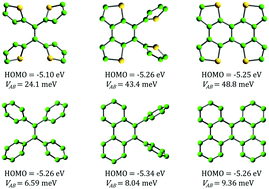Tailoring of the core structure towards promising small molecule hole-transporting materials for perovskite solar cells: a theoretical study†
Abstract
The design of new molecules with theoretical chemistry methods and further obtaining a fundamental understanding of the structure–property relationship are important for the development of high-efficiency hole-transporting materials (HTMs). Herein, the effect of semi-locked and fully-locked cores was systematically investigated based on two conformation-tunable tetrathienylethene (TTE) and tetraphenylethylene (TPE) units. Our results show that the highest occupied molecular orbital (HOMO) levels of the locked TTE-2 and TTE-3 are clearly down-shifted compared with that of the unlocked TTE-1, which is due to the decreased electronic conjugation between the locked cores and the triphenylamine (TPA) arms, whereas the same situation is not found for TPE-3 due to the twisted core configuration. Compared with the TTE-series, the TPE-series exhibits less optical absorption in the visible light region and enhanced stability. Meanwhile, the hole mobility of the designed HTMs displays an increased trend from the unlocked core to the semi-locked and fully-locked cores due to the gradually increasing hole transfer integral with enhanced molecular planarity. In addition, we also found that the reorganization energy of the locked TTE cores is obviously lowered compared to that of the unlocked one, which plays an important role in increasing the hole mobility. In summary, this work can provide some useful clues for designing high-efficiency two-dimensional HTMs, and two potential promising candidates (TTE-3 and TPE-3) are proposed.



 Please wait while we load your content...
Please wait while we load your content...